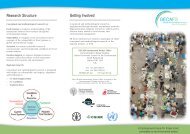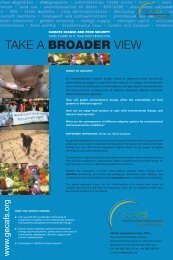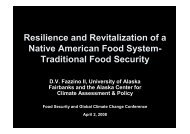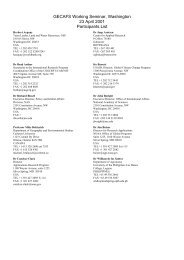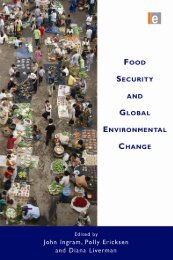From Food Production to Food Security - Global Environmental ...
From Food Production to Food Security - Global Environmental ...
From Food Production to Food Security - Global Environmental ...
- No tags were found...
You also want an ePaper? Increase the reach of your titles
YUMPU automatically turns print PDFs into web optimized ePapers that Google loves.
Finally, it is worth noting that for stakeholder engagement <strong>to</strong> be effective, the personalities ofall those involved are important; human nature can frustrate earnest attempts <strong>to</strong> communicategenially and find consensus. It is crucial not <strong>to</strong> ‘get off on the wrong foot’ so someknowledge of the proposed participants’ personalities is important, especially whenfacilitating first-time interactions. Similarly, knowledge of any ‘his<strong>to</strong>ry’ of prior interactionsbetween stakeholders (be it good or bad) can be very helpful in designing meetings and otherinteractions. Setting the right atmosphere for the meeting is also important and a range ofinformal and/or social activities can be a key aspect for building trust and developingfriendships. These aspects not only help with the meeting itself, but can also develop a strongfoundation for longer-term collaborations.Interactions with stakeholders <strong>to</strong> enhance decision support for food securityThe policy community is often the main stakeholder group of interest <strong>to</strong> researchers workingat the regional level. To be of use in supporting policy formulation, research on thedevelopment and assessment of possible strategies <strong>to</strong> adapt food systems <strong>to</strong> the impacts ofGEC should be elaborated in the context of the policy process. As the food security–GECdebate encompasses many complex and interactive issues, a structured dialogue is needed <strong>to</strong>assist the collaboration among scientists and policy-makers. This can be facilitated by avariety of decision support approaches and <strong>to</strong>ols, ranging from general discussions andmutual awareness-raising (including formal joint exercises such as scenario construction andanalyses; see Box 6) <strong>to</strong> simulation modelling, geographic information systems and other <strong>to</strong>olsfor conducting quantitative analyses of trade-offs of given policy options.Box 6 Using scenario exercises <strong>to</strong> facilitate communication among stakeholders.Scenario exercises can facilitate stakeholder involvement, thus linking research activities more closely<strong>to</strong> actual decision processes. This can be especially effective where dialogue is centred onuncertainties and complexity, and an assessment of future trends is sought – as is the case whendiscussing GEC interactions with medium- <strong>to</strong> long-term implications for food security. Scenarioexercises have shown considerable potential <strong>to</strong> provide a mechanism for involving a range ofstakeholders and for facilitating communication between them. Generally speaking, scenario exercisescan be and have been effective in supporting three main clusters in any assessment (Henrichs et al.,2010):1. The research and scientific exploration cluster (i.e. helping <strong>to</strong> better understand the dynamics of(complex) systems by exploring the interaction between key drivers).2. The education and public information cluster (i.e. providing a space for structuring, conveyingand illustrating different perceptions about unfolding and future trends).3. The decision-support and strategic planning cluster (i.e. offering a platform for soliciting viewsabout expected future developments and <strong>to</strong> analyse trade-offs between pathways).Ideally, a scenario exercise contributes – <strong>to</strong> some degree – <strong>to</strong> all of the above by aiming <strong>to</strong> enhancecredibility through expert knowledge (i.e. ‘Is the exercise convincing?’), salience <strong>to</strong> stakeholders (i.e.80



